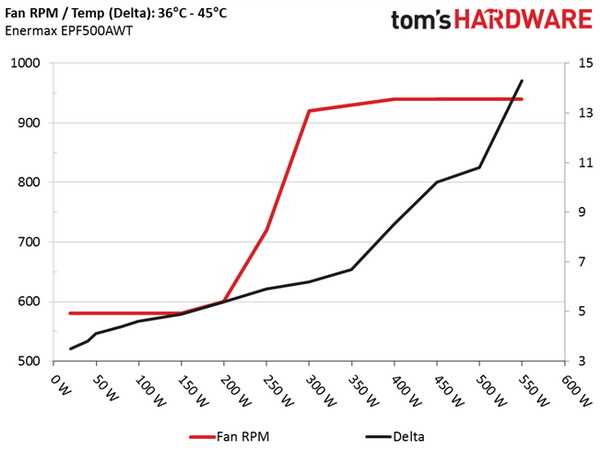Enermax D.F. 500W PSU Review
The Enermax D.F. 500W is a fully modular PSU featuring high efficiency, quiet operation, and individually sleeved cables. But are those enough to justify its premium price tag?
Why you can trust Tom's Hardware
Efficiency, Temperature, And Noise
Efficiency
Our efficiency testing procedure is detailed here.
Using results from the previous page, we plotted a chart showing the EPF500AWT's efficiency at low loads, and loads from 10 to 110 percent of its maximum-rated capacity.
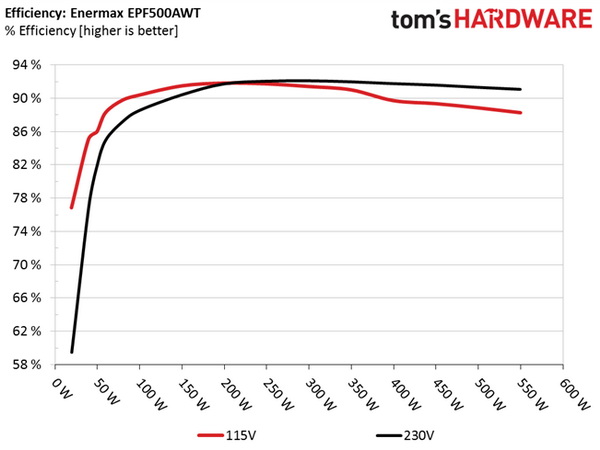
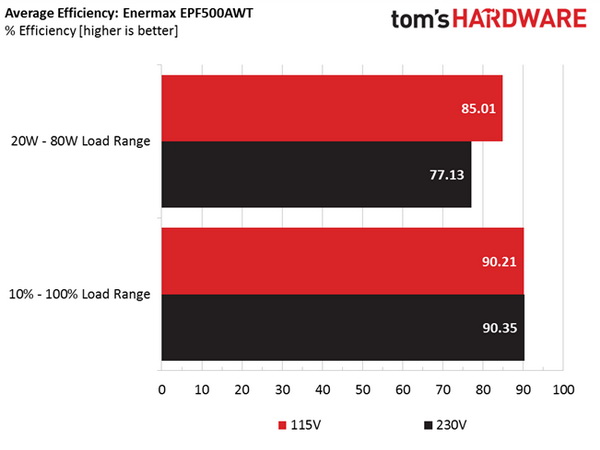

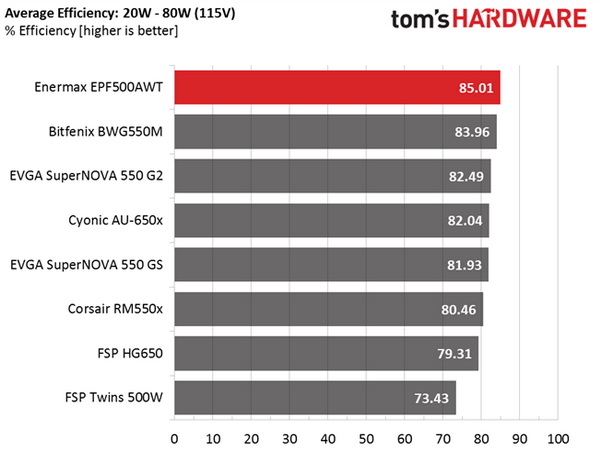
This is a highly efficient PSU that had no trouble beating our comparison units, since the models we can include earned lower efficiency certifications. The only PSU that comes close is Bitfenix's BWG550M, which is based on a very good CWT platform.
Efficiency At Low Loads
In the following tests, we measure the EPF500AWT's efficiency at loads significantly lower than 10 percent of its maximum capacity (the lowest load the 80 PLUS standard measures). The loads we dialed were 20, 40, 60, and 80W. This is important for representing when a PC is idle, with power-saving features turned on.
| Test # | 12V | 5V | 3.3V | 5VSB | DC/AC (Watts) | Efficiency | Fan Speed | Fan Noise | PF/AC Volts |
|---|---|---|---|---|---|---|---|---|---|
| 1 | 1.207A | 0.491A | 0.475A | 0.191A | 19.73 | 76.855% | 580 RPM | 20.8 dB(A) | 0.844 |
| 12.142V | 5.074V | 3.367V | 5.139V | 25.67 | 115.06V | ||||
| 2 | 2.429A | 0.978A | 0.980A | 0.386A | 39.72 | 85.084% | 580 RPM | 20.8 dB(A) | 0.918 |
| 12.139V | 5.070V | 3.361V | 5.129V | 46.68 | 115.06V | ||||
| 3 | 3.660A | 1.473A | 1.485A | 5.120A | 59.88 | 88.300% | 580 RPM | 20.8 dB(A) | 0.940 |
| 12.138V | 5.066V | 3.359V | 5.120V | 67.81 | 115.05V | ||||
| 4 | 4.878A | 1.973A | 1.965A | 0.781A | 79.77 | 89.794% | 580 RPM | 20.8 dB(A) | 0.961 |
| 12.136V | 5.063V | 3.354V | 5.111V | 88.84 | 115.05V |
The fan's noise is minimal in these tests, while efficiency is very high. In three out of the four metrics, efficiency registers way above 80%, and during the last one it's almost 90%.
5VSB Efficiency
The ATX specification states that 5VSB standby supply efficiency should be as high as possible, recommending 50 percent or higher with 100mA of load, 60 percent or higher with 250mA of load, and 70 percent or higher with 1A or more of load.
We take four measurements: one each at 100, 250, and 1000mA, and one with the full load the 5VSB rail can handle.
Get Tom's Hardware's best news and in-depth reviews, straight to your inbox.
| Test # | 5VSB | DC/AC (Watts) | Efficiency | PF/AC Volts |
|---|---|---|---|---|
| 1 | 0.102A | 0.525 | 76.867% | 0.057 |
| 5.147V | 0.683 | 115.10V | ||
| 2 | 0.252A | 1.296 | 80.099% | 0.126 |
| 5.143V | 1.618 | 115.10V | ||
| 3 | 1.002A | 5.130 | 81.493% | 0.304 |
| 5.120V | 6.295 | 115.09V | ||
| 4 | 2.502A | 12.703 | 78.847% | 0.403 |
| 5.077V | 16.111 | 115.10V |
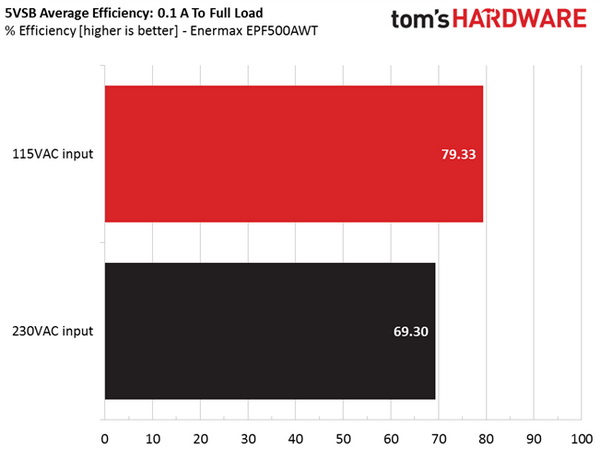
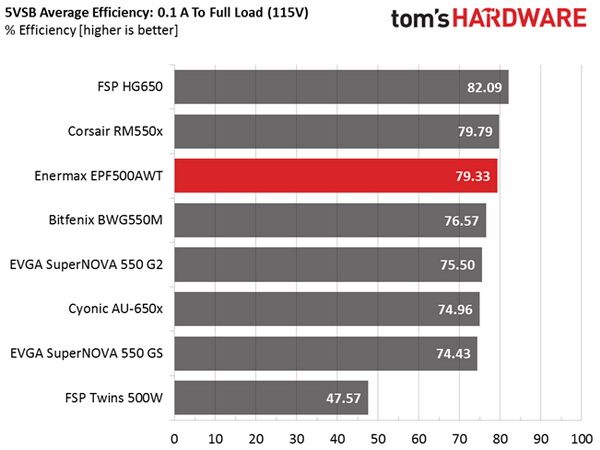
The 5VSB rail registers high efficiency, especially with 115V input.
Power Consumption In Idle And Standby
In the table below, you'll find the power consumption and voltage values of all rails (except -12V) when the PSU is idle (powered on, but without any load on its rails), and the power consumption when the PSU is in standby mode (without any load, at 5VSB).
| Mode | 12V | 5V | 3.3V | 5VSB | Watts | PF/AC Volts |
|---|---|---|---|---|---|---|
| Idle | 12.214V | 5.082V | 3.375V | 5.151V | 7.166 | 0.453 |
| 115.1V | ||||||
| Standby | 0.058 | 0.005 | ||||
| 115.1V |
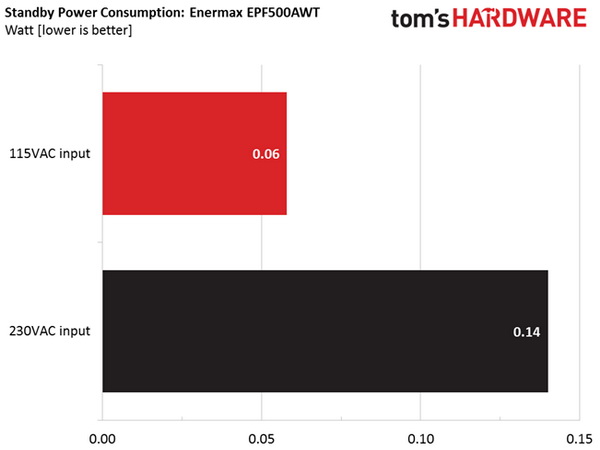

Standby power consumption is very low, and the PSU has no trouble satisfying the ErP Lot 6 2013 requirements.
Fan RPM, Delta Temperature, And Output Noise
Our mixed noise testing is described in detail here.
The chart below illustrates the cooling fan's speed (in RPM), and the delta between input and output temperature. The results were obtained at 36°C (96.8°F) to 45°C (113°F) ambient temperature.
The next chart shows the cooling fan's speed (again, in RPM) and output noise. We measured acoustics from one meter away inside a small, custom-made anechoic chamber with internals completely covered in sound-proofing material (be quiet! Noise Absorber kit). Background noise inside the chamber was below 18 dB(A) during testing, and the results were obtained with the PSU operating at 36°C (96.8°F) to 45°C (113°F) ambient temperature.
The following graph illustrates the fan's output noise over the PSU's operating range. The same conditions of the above graph apply to our measurements, though the ambient temperature was between at 30°C (86°F) to 32°C (89.6°F).
The PSU is very quiet, although it doesn't feature a semi-passive mode. With a low-speed fan and a relaxed fan profile, there is no need for semi-passive operation.
Current page: Efficiency, Temperature, And Noise
Prev Page Load Regulation, Hold-Up Time, And Inrush Current Next Page Protection Features, Evaluated
Aris Mpitziopoulos is a contributing editor at Tom's Hardware, covering PSUs.
-
eglass I'd probably buy it. I like those cables and I'm running a 500W Enermax Liberty that is now 11 years old.Reply -
Anathemata How well does the dust-removal feature work? I mean, Van der Waals force is still a thing, and you need more than just a simple fan to blow out dust. Wouldn't a simple filter suffice?Reply
The sleeved cables are a nice touch. It'll be cheaper than buying a different power supply and separate sleeved cables. -
daddywalter Build quality isn't bad but could be better; lack of OTP is troublesome; and I'll agree with the reviewer that sleeved cables would be better offered as an option for modders. 80 Plus Platinum rating is a plus, of course; and 500 watts is adequate for most general-purpose computers that don't require multiple GPUs -- this PSU would probably outlast most SOHO builds, but then the initial price becomes more of a factor. Nice PSU, but IMHO not worth $140 with only a five-year warranty; at ten years I might consider it since then it should be good for at least three builds.Reply -
dstarr3 Reply19274544 said:I'd probably buy it. I like those cables and I'm running a 500W Enermax Liberty that is now 11 years old.
11 years is plenty of time for a company to have since dropped an amount of build quality. -
Robert Cook I'll add my voice, that auto play video needs to go. It is obnoxious, and adds lag to weaker devices.Reply
I like that cable pattern, it reminds me of the cables on my Enermax revolution 85+ 850W. (a great PSU despite its lower efficiency and age.)
How are poorly trimmed leads going to cause shorts if everything is locked inside a case? I only see that as an issue if you go dropping screws in there. -
Aris_Mp they aren't poorly trimmed only, some of them are really long and only a hair away from the other. Under extreme conditions this can cause problems (shorts) and there can be of course an EMI issue when leads are so close to each other. Also with such long leads the plastic shield under the PCB can get punctured or during the PCB's installation into the chassis, which applies pressure to the leads, the long ones will bend and probably get shorted; this means that some PSUs might be already broken. I don't think that every PSU that leaves the production line is tested, but only a percentage of them.Reply
There is a purpose behind the proper trimming of excessively long leads in every PCB that is installed into a metallic chassis. The use of a plastic shield under the PCB doesn't automatically solves all possible problems. -
WFang I'm hoping for a resurgence in power supply choices in the 500W and *LESS* category!Reply
I would rather see something like the amazing Seasonic Prime supplies in a 400W flavor than 600W and over...
Before I go on, I realize that if you run two GPU's or you really like to OC, obviously you need more and want more.. Great.. you already have a ton of great choices for those use-cases... I just wonder why we don't have more great quality choices in the lower Wattage ranges where probably a good 75% of even the enthusiast group could live comfortably.
I also realize that TDP - Thermal Design Power is NOT the same as power consumption, but it is easy to find TDP numbers, and a part that is designed to deal with e.g. 100W TDP is likely to consume around 100W (or less) even in peak. As such it becomes a handy metric for back of the envelope power budgeting that still ends up being fairly conservative.
With CPU's now more often in the lower half of 45W, 65W, and 95W TDP and the more recent GPU's all sitting at 300W or less in TDP, I'd argue that for non-OC'ed systems with one GPU and 1 or 2 HDD's and maybe an SSD, a great high efficiency 350W to 400W PSU will be a great choice. Feeling like that is pushing it? Fine, go 500W... but I don't see why you'd shop higher than that (for this use-case). Yet, good quality Titanium, Platinum, or Gold efficiency PSU's seem so hard to find in the sub 500W range. :(
On a side note, since I'm here complaining anyway: A looong time ago I heard Tom's mention the Seasonic Prime 600W fanless PSU, anyone know if/when that will become available in the US? (Or anywhere?)??? -
Marcus52 Reply19274544 said:I'd probably buy it. I like those cables and I'm running a 500W Enermax Liberty that is now 11 years old.
Enermax was my favorite PSU maker when they made their own, but unfortunately they've chosen OEMs that are "adequate" not "great" to replace their manufacturing facility. I've paid their premium in the past, but right now EVGA is on the top of my list. Super Flower makes their top-of-the-line PSUs and build quality is superb, as are test bench results.
Seasonic is also on my list of "will buy", and several other brands use Seasonic or Super Flower, so I wouldn't be opposed to buying one from someone like Corsair - as long as it tested well on reputable hardware sites.
Never buy a PSU that doesn't review well. I've learned that the hard way. Build quality matters.
